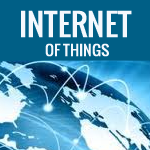What is the Internet of Things?
Connecting Remote electronic devices to each other via the internet
and allowing them interact with each other independent of humans
is a phenomenon called the Internet of Things.
The term, Internet of Things (IoT), was first used in 1999 by Kevin Ashton
to denote all the equipment (things) that can be connected
to each other over a network.
The development of the Internet of Things
As Internet speeds increase and data costs come down it’s becoming
more feasible to connect devices to each other for various purposes.
Typically a chip or radio-tag is installed in the equipment that you want connected to
each other or via the Internet. These chips can also be used to communicate with each
other as well as with other such connected devices. Thus, machine-to-machine
communication forms the crux of Internet of things.
IoT is fast growing in popularity and as per research, there will be more than 5 billion chips installed in various equipments in the current year to enable them to connect on a network. A staggering prediction is that by 2025 there will be approximately 50 Billion devices connected to the Internet.
Naturally, data generated by these connected devices will also be large in volume.
Technology needs to be in place to capture, store and retrieve this data, because without the data, just connecting the devices will not be of any use. One more aspect of Internet of Things is that the sensors and chips not only generate large volumes of data but that too at a large speed. So, to make the Internet of Things effective, the devices and applications handling this data need to be able to process the data fast enough for the users to comprehend and use.
The importance of Cloud computing to the Internet of Things
To handle these large volumes as well as faster speed of data, the newly developing Cloud Computing technology will be very helpful. Cloud Computing is a virtual infrastructure managed by different vendors and it provides services like infrastructure, software, database management, etc. This utility-based model will help businesses to access applications and data on demand from anywhere at any time. Because of the cloud being used, human intervention will be reduced and this will ensure that the data is kept clear of human interference as much as possible.
But, by combining IoT and cloud computing, there may be challenges with the data being handled –
1. There are concerns regarding the privacy of individuals when all the devices that they use are connected via the Internet. As we move ahead with this technology, one of the most important issues to be addressed would be that of protection of privacy.
2. One more aspect is that of the security of data. With the number of malware and hackers using these malware for criminal activities, being on the rise, protecting the data that is available on the cloud becomes paramount.
There are other technologies available, like encryption and website scanning and security services that can ensure protection of information. So, when a business uses cloud services, it needs to ensure that these data protection services are available with the vendor.
To conclude, Cloud computing is an essential element in the development of the Internet of Things,
if it’s to be a successful technology, but at the same time, we need to be sensitive about protecting personal privacy and information by using the best available technologies and business processes.
Thanks the TIB Team
